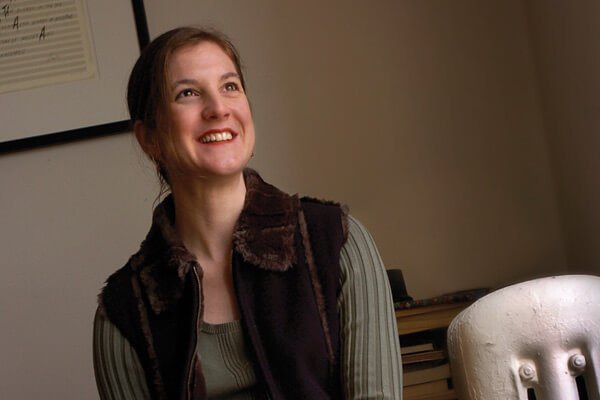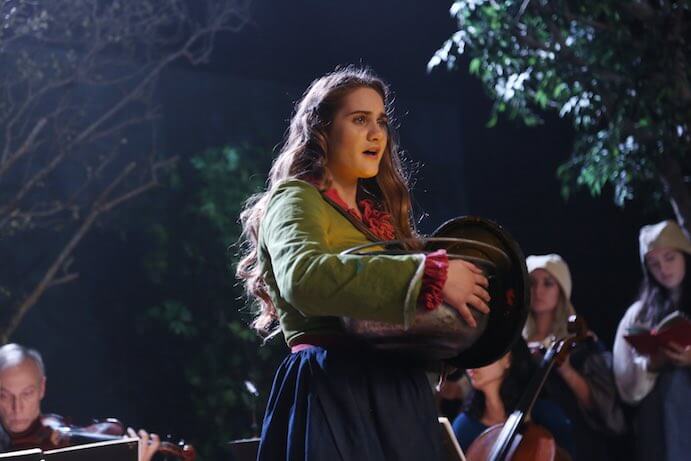Lisa Bielawa is a composer, vocalist, and co-founder of the MATA Festival whose works frequently draw from literary influences and have been performed at the New York Phil Biennial and at venues across the U.S. In addition to a broad output of vocal, chamber, and orchestral compositions, Bielawa is also the author of Airfield Broadcasts, a piece whose instrumentation is designated “for hundreds” and which is meant as a “large-scale spatial acoustic musical celebration” musically navigating the space of the Tempelhofer Park in Berlin.
Most recently, Bielawa has composed Vireo, a “made-for-TV-and-online” opera exploring the politics of gender identity and literary interpretation, and featuring collaborations with Kronos Quartet, the San Francisco Girls Chorus, Magik*Magik Orchestra, American Contemporary Music Ensemble, and Alarm Will Sound, among others. All 12 episodes are now available to stream via KCET, and Vireo will be shown in its entirety at National Sawdust on July 7, 2017 at 7:00pm.
Can you talk a bit about your exploration of gender identity, and more specifically, of gendered interpretation of texts (be they historical, literary, or musical)?
Because I was both researcher and composer for Vireo, along with various other roles (like Executive Producer, and – briefly – in Episode 11 – a singing cameo), I had several different relationships with the material. I did the bulk of the historical research back in 1989-90 when I was an undergraduate at Yale, and this process was liberating for me, full of mystery and intensity. Discovering these young women’s voices, emerging as they did (often only palimpsestically through the collective voices of their doctors, priests and townsmen) made me feel connected to a whole centuries-long tradition of resistance through visionary states. While I was certainly in thrall to these discoveries because I myself was a young woman and felt a strong identification with these girls, I did not see my actual interpretation of these texts as ‘gendered’ per se. I have had similarly powerfully-identified responses to texts that have nothing to do with gender. As a composer, I am not aware of my gender at all while actually writing music. Notes and rhythms and sonorities do not make me particularly aware of being any gender or age or race. Some people feel these things are informing one’s work unconsciously or even genetically (essentialism), and I will leave this discussion to musicologists, anthropologists, and the like. Using these tools (notes, rhythms, sonorities, pacing, etc.) to create emotional terrain is essential to creating powerful work, of course–but this is true whether my protagonist is a 14-year-old girl or a 20th century male Russian poet. My job is to communicate an emotional journey, and as an artist I expect myself to be able to engage with the plight of any hero (of any gender) and make it vivid for a listener (of any gender).

Were Robert Ashley’s “TV operas” an inspiration for the work? What do you think are some of the possibilities for “made-for-TV (or online) opera” moving forward?
I would love to say that I drew inspiration from these but the truth is that I don’t know them. Now that I am finally finished with the deeply involving multi-year process of writing Vireo, I hope to have a chance to learn more about Ashley’s groundbreaking operas. I am happy to see that a lively discussion is brewing around new possibilities for opera, and even gladder to know that some of my colleagues may see our work in the context of this new surge. Of course it is always a great hope that one’s work will catalyze new vitality within the field at large! Because I have been 100% engrossed in creating Vireo as a new possible way to create opera for TV and streaming media, I have not yet had a chance to imagine still more possibilities. I guess this means that–at the moment, having only just completed post-production on Vireo less than a week ago, the entire answer to your second question lies in the work itself. Check in with me in a month!
The work features collaborations from literally hundreds of musicians and production began in early 2015. What was the journey like from inception to final project?
It was a whole lifestyle. We formed a massive, constantly changing organism with new relationships and energies being created all the time. It has been all-consuming for me, and the pleasure and privilege of being able to draw so many of my colleagues, new and old, together, and to mentor so many young people along the way, was a thrill. It was also an extremely compatible creative team–working with Erik [Ehn] and Charlie [Otte] created a feedback loop that spiraled constantly upwards. We challenged each other and sparked each other’s imaginations, constantly raising the bar in an atmosphere of joy and deep respect–and all of this was palpable to the whole team (cast, crew, designers, musicians), so it was infectious.

Made-for-online opera allows for the engagement of a more global community than the average Brooklyn new music ensemble playing for an audience of 12 people. What are your thoughts about virtual musical experiences and the different sorts of realities and temporalities they allow for?
I value all kinds of musical experiences, including the ephemeral and the intimate. The biggest discovery for me in this process was how much I loved the Shoot as a performative space: finding ways to capture the edge of live virtuoso performance, while adding this new component of close Steadicam filming. I also love the idea of bringing the degree of agency to which we have all become accustomed in our private streaming entertainment habits (binge-watching, watching episodes out of order, watching them multiple times, taking control of when and how we wish to take in a story) to the experience of opera. That creates a really exciting set of new questions around reception for us composers to consider!
What can we expect of the musical language of Vireo?
While Vireo certainly has its own dialect, borne out of the specific thematic units–melodic fragments that get transformed, combined and reused; harmonic sonorities that imbue the characters’ experiences with specific emotional colors–the overall language is much like other works of mine. Attentive listeners will likely hear Renaissance polyphony, aspects of the epic symphonic poem, contemporary techniques absorbed by osmosis through my own 25+ years of singing the work of my colleagues and mentors, and even some of the flavor of the early 20th-century French music that was around at the time of the Surrealists, whose collaborative writings were among those that I studied when I was researching Vireo as an undergrad. In this work, as in much of my work, I embrace and celebrate virtuosity–vocal and instrumental–as a manifestation of the wonders of human capacity and endeavor. There are a lot of colors in Vireo–with so many different ensembles of different sizes and makeups, from Partch instruments to marching band to string quartet to solo harp and hurdy-gurdy. It really gave me an opportunity to serially expand and deepen my relationship with each of these sound worlds, while still creating work that was within the overarching musical dialect that articulates Vireo’s reality.
























